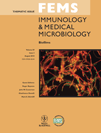Bacterial biofilm on monofilament suture and porcine xenograft after inguinal herniorrhaphy
Editor: John Costerton
Abstract
Bacterial biofilms have been implicated in multiple clinical scenarios involving infection of implanted foreign bodies, but have been little studied after hernia repair. We now report a case of revision inguinal herniorrhaphy complicated by chronic pain at the operated site without any external indication of infection. Computed tomographic imaging revealed a contrast-enhancing process in the left groin. Subsequent surgical exploration found an inflammatory focus centered on implanted porcine xenograft material and nonabsorbable monofilament sutures placed at the previous surgery. Confocal microscopic examination of these materials with Live/Dead staining demonstrated abundant viable bacteria in biofilm configuration. The removal of these materials and direct closure of the recurrent hernia defect eliminated the infection and resolved the patient's complaints. These results demonstrate that implanted monofilament suture and xenograft material can provide the substratum for a chronic biofilm infection.




